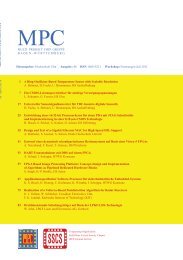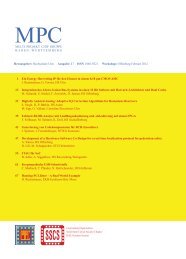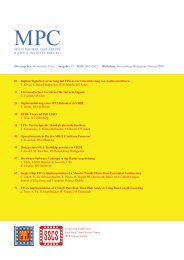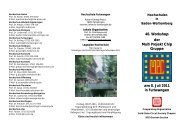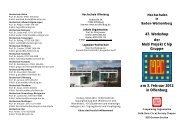Workshopband als PDF - Mpc.belwue.de
Workshopband als PDF - Mpc.belwue.de
Workshopband als PDF - Mpc.belwue.de
Erfolgreiche ePaper selbst erstellen
Machen Sie aus Ihren PDF Publikationen ein blätterbares Flipbook mit unserer einzigartigen Google optimierten e-Paper Software.
Table 5: Data Registers<br />
Address Register<br />
0x10 SYN<br />
it after the ENDP field. At the end of the transmission<br />
it provi<strong>de</strong>s the EOP for the nee<strong>de</strong>d 2 bit times.<br />
3) Data Packets Structure<br />
The block for data packets has the same logic behind<br />
it as the block for token and handshake packets. It<br />
begins with loading the data registers and ends with<br />
the control state machine. The addresses for the block<br />
of registers for the Data are stated in Table 5. The<br />
NUM register tells how many bytes of data will be<br />
transmitted.<br />
The calculated CRC 16 is loa<strong>de</strong>d directly from the<br />
CRC 16 calculator. Whether the CRC calculated or<br />
stored is used, is <strong>als</strong>o stated by the CTRL register in<br />
the Token and Handshake registers structure. All the<br />
blocks in the Data structure are controlled by the control<br />
state machine insi<strong>de</strong> the data structure. Its performance<br />
is almost the same as the one for token and<br />
handshake packets; it keeps count of how many bytes<br />
are sent, enables and clears the CRC16 calculator and<br />
provi<strong>de</strong>s the time for the EOP.<br />
4) Selection and Formatting of Output<br />
This block is in charge of selecting between the token<br />
and handshake packet serial output and the data<br />
serial output to perform the bit stuffing, NRZI encoding<br />
and the differential output. The selection is done<br />
via some multiplexers controlled by the Drun and<br />
THrun sign<strong>als</strong>, during every transmission only one of<br />
the two lines can be activated.<br />
The bit stuffing sends a next signal to the control<br />
state machines to ask for the next bit of the string,<br />
when six one bits are encountered, the signal nxt is<br />
stalled and a zero bit is inserted and endorsed with the<br />
valid bit in the output section. After the bit stuffing is<br />
done, the NRZI encoding and the differentiation of the<br />
output take place.<br />
54<br />
0x11 PID<br />
0x12<br />
CRC stored<br />
first byte<br />
0x13<br />
CRC stored<br />
second byte<br />
0x14-<br />
0x33<br />
Data Bytes<br />
--<br />
CRC 16<br />
calculated<br />
0xF0 NUM<br />
C. Receiver<br />
VHDL BASED CIRCUIT DESCRIPTION TO TRANSMIT,<br />
RECEIVE AND ANALYSE USB DATA PACKETS<br />
Figure 4: Receiver<br />
The receiver is in itself divi<strong>de</strong>d into several different<br />
structures: the differential input block, the blocks for<br />
EOP and SYN <strong>de</strong>tection, the block for synchronization,<br />
the blocks for NRZI <strong>de</strong>coding, <strong>de</strong>-bit stuffing and<br />
CRC checking, the block with the shift register and<br />
the saved received data, and finally the control finite<br />
state machine. The whole receiver structure is shown<br />
in Figure 4.<br />
1) EOP Detection and Differential Input Blocks<br />
As inputs of the structure there are 2 D+ lines and 2<br />
D-, one set of them go to the EOP <strong>de</strong>tection block to<br />
be able to recognise the SE0 part of the EOP. The<br />
other set of lines are inputs of the differential input<br />
block, where a primitive from the Xilinx Unified Libraries<br />
for the Spartan 3E board was used, the<br />
IBUFDS differential signaling input buffer with optional<br />
<strong>de</strong>lay, to retrieve the data from the differential<br />
lines. Another function of the differential input block<br />
is to do two samplings of the data line; first with the<br />
positive edge of the clock, the second with the negative.<br />
2) DPLL for Synchronization and SYN Detection<br />
Blocks<br />
A digital phase locked loop is implemented through<br />
a state machine to keep track of the changes in the<br />
data line in the positive and the negative edges of the<br />
internal clock. Then some sign<strong>als</strong> for data available dv<br />
are created to indicate a reliable place of the bit cell to<br />
be read, the best dv signal can be manually selected by<br />
the input mux of the block. The DPL needs at least 2<br />
changes in the lines to lock the internal clock with the<br />
signal.



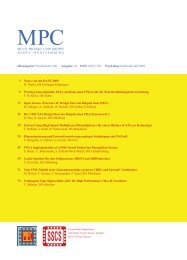
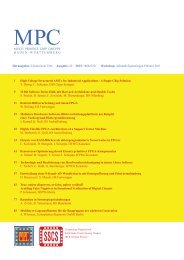
![[Geben Sie hier die Überschrift ein] - MPC](https://img.yumpu.com/8654082/1/188x260/geben-sie-hier-die-uberschrift-ein-mpc.jpg?quality=85)
